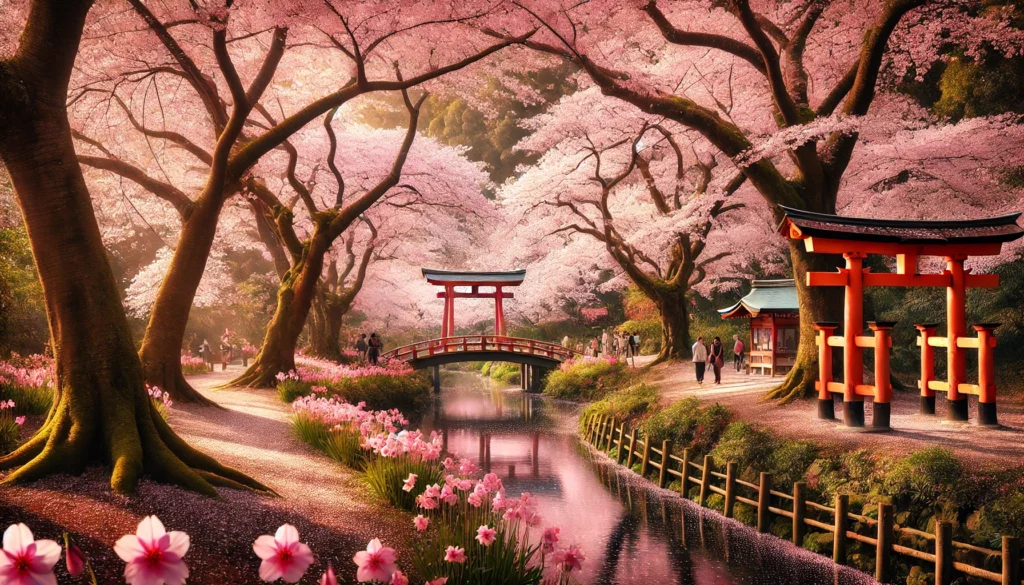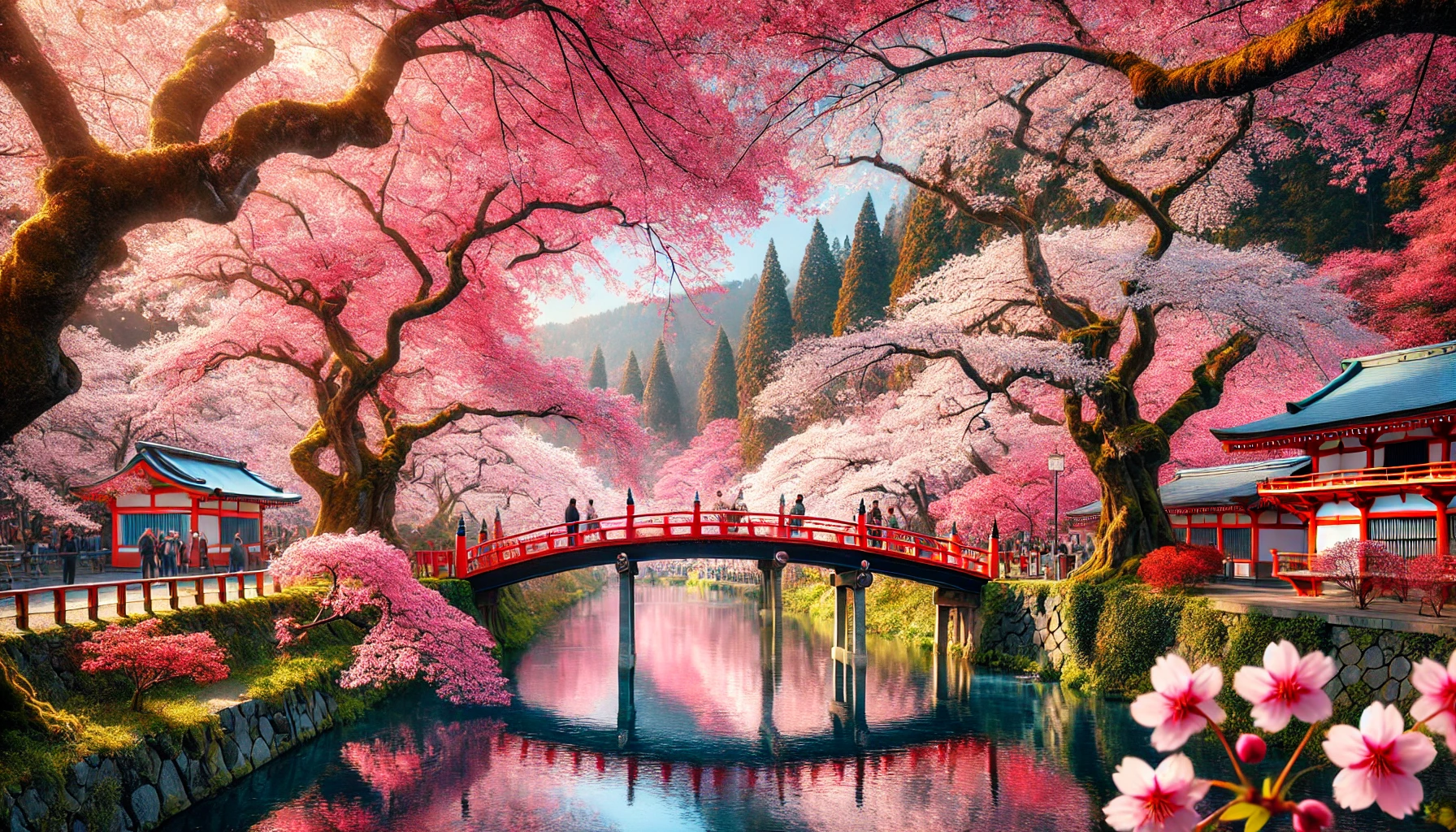Table of Contents
Introduction to Cherry Blossom Season in Japan
Cherry blossom season, or Hanami, is one of Japan’s most celebrated cultural phenomena, drawing countless visitors and locals to parks and gardens each spring. The blossoms, primarily of the sakura tree, hold deep significance in Japanese society, symbolizing the transient nature of life. Their brief yet stunning display captures the essence of beauty and impermanence, themes that resonate strongly within the Japanese ethos.
The tradition of Hanami dates back over a thousand years, flourishing during the Heian period when aristocrats would gather beneath cherry trees to compose poetry and enjoy the fleeting beauty of the blossoms. Over time, this custom evolved into a national pastime, transcending social class and becoming a cherished aspect of contemporary Japanese culture. Festivals often accompany this enchanting season, featuring food stalls, cultural performances, and nighttime illumination, all enhancing the experience of celebrating these delicate flowers.
As the buds begin to bloom, anticipation builds across the country, with cherry blossom forecasts captivating media and shaping travel plans. Parks such as Ueno in Tokyo and Maruyama in Kyoto become vibrant gathering spots, as families, friends, and colleagues come together for picnics under the trees. This social aspect of Hanami fosters a sense of community and connection, reinforcing the emotional ties that many Japanese people have with the cherry blossoms. The shared experience of enjoying nature’s beauty forms lasting memories and highlights the importance of cherishing the present moment.
In summary, cherry blossom season represents a fascinating intersection of nature, culture, and personal reflection in Japan. The celebration of these fleeting blooms encapsulates deep-rooted traditions and offers a unique glimpse into the beautiful, transient nature of life, making it an essential experience for both locals and visitors alike.

The Timing of Cherry Blossom Viewing
The cherry blossom season in Japan, known as hanami, typically unfolds between late March and early April, offering breathtaking vistas in various locations across the country. However, the specific timing of the blooms can vary significantly due to several crucial factors, including climate conditions, geographic differences, and yearly variations in weather. This ephemeral period is not only a celebration of nature but also a culturally significant event that attracts both locals and international visitors alike.
The blooming process begins in the southern regions of Japan, such as Kyushu and Shikoku, where warmer temperatures can trigger the sakura trees to flower earlier. As the season progresses, the blooms gradually move northward, reaching the renowned cherry blossom spots in cities like Tokyo, Kyoto, and Hiroshima. Factors such as sudden temperature drops and unseasonable weather may influence the timing of the blossoms, leading to unpredictability from year to year. Hence, to fully appreciate the beauty of cherry blossoms, it is essential to stay informed about local forecasts and seasonal predictions.
For those wishing to witness this natural spectacle, it is advisable to track bloom forecasts published by meteorological agencies and tourism boards. These resources provide updates on impending blooming dates and peak viewing times, allowing visitors to plan their trips effectively. Additionally, local festivals coinciding with hanami often host events that enhance the experience, offering food booths and performances, thus providing a holistic cultural immersion during the viewing period.
In summary, understanding the timing and factors influencing cherry blossom seasons in Japan is crucial for anyone hoping to partake in this ephemeral spectacle. By leveraging resources available for bloom forecasts and being adaptable to weather changes, visitors can ensure a memorable hanami experience amidst the stunning blossoms.
Top Cherry Blossom Viewing Spots in Tokyo
Tokyo, a bustling metropolis, transforms into a picturesque landscape during cherry blossom season, offering numerous breathtaking spots for hanami, the traditional practice of enjoying blossoms. Among the prominent locations, Ueno Park stands out. This expansive oasis features over 1,000 cherry trees lining its pathways, making it a popular destination for both locals and tourists. The park’s lively atmosphere is complemented by various food stalls and cultural events, allowing visitors to immerse themselves in Japanese traditions while enjoying the blooming sakura. The best time to visit is typically late March to early April, aligning with the iconic pink blooms.
Another exceptional location is Shinjuku Gyoen National Garden, known for its tranquil setting amidst the urban jungle. This expansive garden houses more than 1,300 cherry trees, showcasing diverse varieties that bloom at different times, ensuring prolonged viewing potential. With its meticulously landscaped lawns and picturesque ponds, the atmosphere here is serene, making it an ideal spot for introspective walks or leisurely picnics. Visitors are encouraged to explore the garden’s pathways, especially during the peak bloom to fully appreciate the splendor of the cherry blossoms. Shinjuku Gyoen can be accessed via Shinjuku Station, making it convenient for travelers.
Lastly, Chidorigafuchi offers a unique cherry blossom viewing experience along the moats of the Imperial Palace, where rows of cherry trees create a stunning display reflected on the water below. Rent a boat to experience the blossoms from a different perspective or stroll along the scenic pathways, where hundreds of trees line the route. This location’s historic backdrop enhances the beauty, making it especially memorable during the seasonal bloom. Visitors can experience Chidorigafuchi in early April, as the blossoms typically reach full bloom around this time, with the added bonus of nearby attractions like the Imperial Palace East Gardens.

Iconic Cherry Blossoms in Kyoto
Kyoto, a city renowned for its historical significance and cultural heritage, offers some of the most breathtaking cherry blossom viewing sites in Japan. Among these, Maruyama Park stands out as a premier location to witness the beauty of sakura in full bloom. This expansive public park, which dates back to the Edo period, features over 800 cherry trees, including the famous weeping cherry tree, which becomes a spectacular sight during peak bloom. Visitors are often drawn to the park for hanami, or cherry blossom viewing parties, where locals and tourists alike gather beneath the trees to celebrate the fleeting beauty of spring.
Another must-visit spot in Kyoto is the Philosopher’s Path, a scenic walkway that meanders alongside a cherry-tree-lined canal. This path, which runs from Ginkaku-ji (Silver Pavilion) to Nanzen-ji, offers a picturesque route for leisurely strolls while enjoying the sight of cherry blossoms in full bloom. As one wanders along the 2-kilometer route, numerous cafes and small shops provide opportunities to savor local delicacies and refreshments, complementing the tranquil atmosphere of the blooming surroundings.
Additionally, Kiyomizu Temple, a UNESCO World Heritage site, offers an iconic backdrop for cherry blossom enthusiasts. With its wooden stage jutting out over the hillside, visitors are treated to panoramic views of both the temple and the cherry blossoms that surround it. The temple often hosts special evening illuminations during the cherry blossom season, enhancing the experience with stunning visual displays as the blossoms light up against the night sky.
To further enrich the experience, visitors to Kyoto can participate in traditional tea ceremonies or local festivals that celebrate the arrival of cherry blossoms. Such cultural events not only enhance the joy of sakura season but also provide deeper insight into Japan’s rich traditions, making Kyoto a truly iconic destination for cherry blossom viewing.

Cherry Blossom Hotspots Outside Major Cities
While Japan’s major cities, such as Tokyo and Kyoto, are renowned for their cherry blossom viewing spots, there are numerous picturesque regions outside these urban centers that offer equally stunning experiences. Among these, Mt. Yoshino in Nara Prefecture stands out as a prime destination for cherry blossom enthusiasts. This UNESCO World Heritage site is famous for its vast array of cherry trees that blanket the mountainside, creating a breathtaking spectacle during the sakura season. Visitors can explore various walking trails, each offering unique vantage points of the expansive cherry blossom views, ensuring a tranquil experience that contrasts sharply with the hustle and bustle of city life.
Another notable hotspot is Hirosaki Park in Aomori Prefecture, which is celebrated for its historic significance and natural beauty. The park, surrounding Hirosaki Castle, boasts over 2,500 cherry trees, providing a stunning backdrop that highlights the seasonal beauty of the blossoms. Visitors can enjoy traditional events during the cherry blossom festivals, where local culture shines through food stalls and performances. The atmosphere created by the combination of historic architecture and vibrant cherry blossoms makes Hirosaki Park an exceptional destination for those looking to immerse themselves in the seasonal splendor.
In addition to these two locations, smaller towns and rural areas across Japan host their own cherry blossom celebrations, often featuring local traditions and customs that enhance the viewing experience. Whether exploring the serene landscapes of Mt. Yoshino or indulging in the cultural heritage of Hirosaki Park, travelers are encouraged to venture beyond Japan’s urban regions. These off-the-beaten-path cherry blossom hotspots provide a serene and memorable opportunity to appreciate the delicate beauty of sakura in all its glory, offering a unique antidote to the frenetic energy of city life.
Cultural Activities and Festivals During Hanami
Cherry blossom season, known as Hanami in Japan, transcends mere flower viewing; it embodies a rich tapestry of cultural activities and festivals that draw both locals and visitors into an immersive celebration of spring. The practice of gathering beneath blooming cherry trees for picnicking is a centerpiece of this season. Families, friends, and colleagues come together to enjoy Hanami parties, often characterized by colorful mats laid across the grass, brimming with an array of traditional Japanese foods. These gatherings not only celebrate the ephemeral beauty of the blossoms but also foster community bonds, reinforcing relationships among participants.
A notable aspect of the Hanami experience is the array of local festivals that spring up as the sakura bloom. These festivals, often featuring traditional music, dance performances, and craft markets, add vibrancy to the atmosphere and showcase regional customs. Many parks hosting cherry blossoms will hold special events, including tea ceremonies where participants can enjoy matcha amidst the delicate pink petals. The melding of nature and tradition during these celebrations creates a unique cultural experience, reminding attendees of the deep historical significance of hanami in Japanese society.
In addition, local food markets make their presence felt during this enchanting time. Seasonal foods, such as sakura mochi (rice cakes wrapped in cherry blossom leaves) and various bento options featuring cherry blossoms in their design, enhance the sensory experience. These culinary offerings not only cater to the festive spirit but also emphasize the importance of seasonal ingredients in Japanese cuisine. With every bite, participants can savor the essence of spring, making the annual cherry blossom season not just a visual spectacle but a feast for all senses.
Tips for Enjoying the Cherry Blossom Season
Experiencing the breathtaking beauty of cherry blossoms can be a highlight of a visit to Japan. To maximize this experience, consider several practical tips that enhance both enjoyment and appreciation of this fleeting season. Timing is crucial; the cherry blossoms, or sakura, bloom for a short period, usually from late March to early April. It is advisable to monitor cherry blossom forecasts available through various websites to determine the best times to visit popular spots.
When planning your visit, aim for early mornings or weekdays to enjoy fewer crowds. Iconic locations such as Ueno Park in Tokyo, and Maruyama Park in Kyoto tend to attract many visitors during peak bloom, so an early start can provide opportunities for better photography and a more serene atmosphere. For photography enthusiasts, utilizing natural light during the golden hours — shortly after sunrise or before sunset — will yield stunning images. Furthermore, consider experimenting with different angles to capture the blossoms in their full glory, including close-ups of flowers against a backdrop of blue sky.
Etiquette is essential during the Hanami season, when people picnic under the cherry trees. It is customary to respect the natural surroundings, so avoid picking blossoms or damaging trees. When locating a suitable spot for your picnic, keep in mind that arriving early can help you secure prime locations. Bring a blanket and enjoy traditional Japanese snacks while surrounded by the picturesque scene.
Lastly, always be mindful of your surroundings and fellow hanami enthusiasts. Navigating crowds can be challenging, so staying patient and courteous can enhance the experience for everyone. Implementing these strategies will ensure that your cherry blossom viewing becomes a memorable occasion, celebrating both culture and nature in Japan.
Sustainable Travel During Cherry Blossom Season
As travelers flock to Japan to witness the breathtaking cherry blossoms, it becomes increasingly important to embrace sustainable travel practices. Observing the delicate beauty of sakura blooms doesn’t have to come at the expense of our environment. By making conscious decisions during your visit, you can contribute to the preservation of these natural wonders while respecting local communities.
A key aspect of sustainable travel is minimizing waste. Visitors should strive to avoid single-use plastics by bringing reusable bags, water bottles, and utensils. Many popular viewing sites offer food and drink options, but opting for local eateries or markets not only reduces waste but also supports the local economy. Engaging with local businesses fosters a sense of community and allows visitors to experience authentic Japanese culture firsthand.
Respecting nature is another crucial element to consider. When enjoying cherry blossoms, it is essential to stay on designated paths and refrain from picking flowers or trampling on grass. Such actions can lead to ecological damage, as cherry trees are sensitive to disturbance. Additionally, maintaining cleanliness by disposing of trash properly or taking it with you reflects a commitment to preserving the environment for future visitors.
Moreover, consider sustainable transportation options during your cherry blossom journey. Utilizing public transportation systems, like trains and buses, significantly reduces your carbon footprint compared to renting a car. Kyoto, for instance, boasts an efficient public transport network that connects major cherry blossom sites. Cycling is another fantastic way to explore the area while minimizing environmental impact.
In conclusion, adopting sustainable travel practices during cherry blossom season is not merely an option, but a responsibility for every visitor. By being mindful of our actions and supporting local communities, we can enjoy the serenity of cherry blossoms while ensuring their beauty endures for generations to come.
Conclusion: Embracing the Beauty of Cherry Blossoms
The cherry blossom season in Japan is a breathtaking display of nature’s beauty that many look forward to each year. As the delicate pink petals bloom, they create a picturesque backdrop that fills parks and landscapes with vibrant hues, attracting both locals and tourists alike. This annual event is not just a visual spectacle; it embodies the essence of fleeting beauty, reflecting themes of renewal and hope intrinsic to Japanese culture. The tradition of Hanami, or flower viewing, encourages individuals to gather beneath the blooming trees, fostering connections and appreciation for these short-lived marvels.
Experiencing cherry blossoms in person allows one to engage deeply with Japan’s rich cultural heritage. The event serves as a reminder of life’s ephemeral nature, urging observers to seize moments and revel in their beauty, no matter how brief they may be. Each year, the cherry blossoms remind us to look forward, welcoming change and the arrival of spring, symbolizing new beginnings and the persistence of life despite hardships. This universal theme resonates with people across cultures, prompting them to pause and reflect on their own realities.
As you consider embarking on a journey to witness this iconic phenomenon, remember that the cherry blossom season offers not only spectacular sights but also an opportunity for personal growth and cultural connection. The serene ambiance of Hanami encourages mindfulness, allowing one to appreciate the beauty around them in the present moment. By visiting Japan during this enchanting time, you will create lasting memories that emphasize the importance of cherishing life’s fleeting moments, enhancing your understanding of nature’s cycles and the broader human experience.






